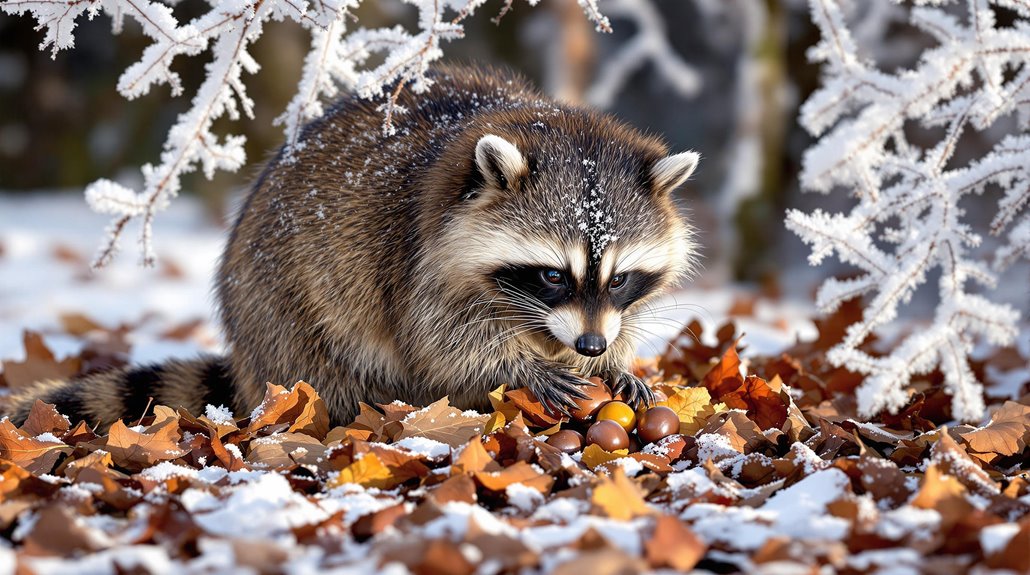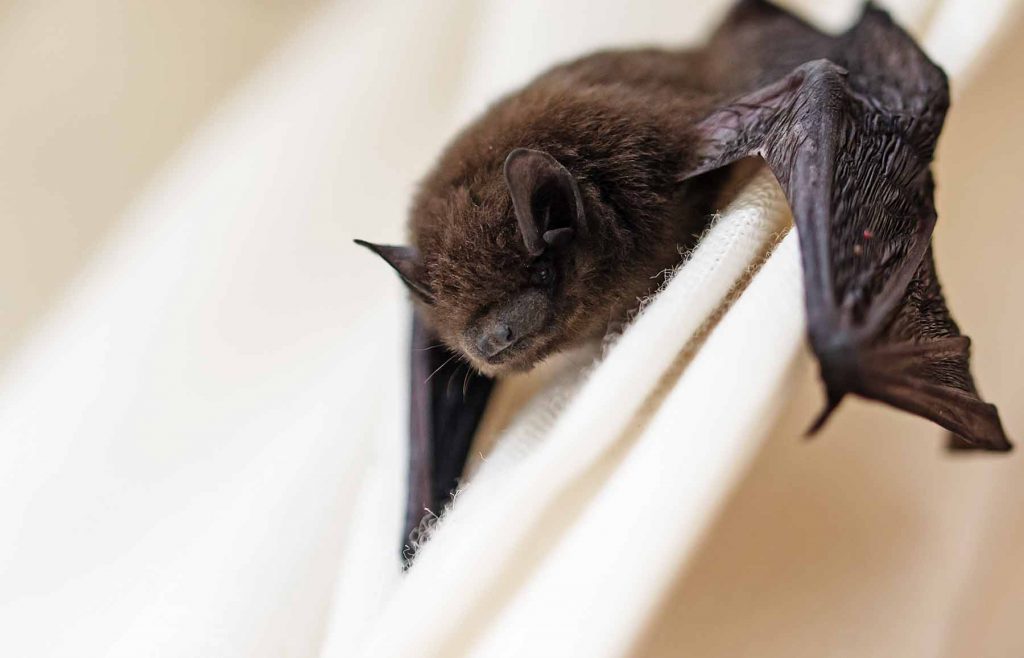In winter, raccoon activity in Raleigh, NC, changes to adapt to colder weather. They become more nocturnal, seeking food at night while avoiding predators. Raccoons often forage through urban trash cans for food, as urban areas provide easy access to human leftovers. Their shelter choices also evolve, with many using attics, abandoned buildings, or tree cavities for warmth. Social dynamics remain important, as raccoons communicate and share resources within their groups. To understand how these behaviors impact local communities, consider exploring more about their interactions with the environment and human safety measures.
Key Article Highlights
- Raccoons in Raleigh become more nocturnal during winter months to avoid predators and search for food.
- They adapt their foraging strategies, scavenging human food sources like trash and pet food in urban areas.
- Preferred winter shelters include tree cavities, attics, and abandoned buildings, providing warmth and safety from harsh weather.
- Social dynamics remain important, with young raccoons learning survival skills from older members during seasonal gatherings.
- Cold weather can lead to increased human encounters, emphasizing the need for securing trash bins and avoiding leaving food outdoors.
Raccoon Behavior in Winter
During the winter months, raccoons exhibit distinct behavioral changes to adapt to the colder environment. As temperatures drop, these animals become more cautious in their activities. Raccoons are primarily nocturnal, meaning they are most active at night. This behavior helps them avoid daytime predators and find food more easily.
Raccoon foraging becomes a key focus during winter. They search for food sources, often relying on their excellent sense of smell. In colder months, food can be scarce, prompting raccoons to explore new areas for sustenance. They may venture into urban settings, rummaging through trash and searching for leftover food. This increase in urban foraging can lead to potential property damage as they may tear into trash cans or even enter homes in search of food.
Additionally, raccoons will often seek shelter in warmer locations. They may find refuge in dens or burrows, which provide protection from harsh weather. These adaptations are vital for their survival during the winter months. The balance between foraging for food and finding safe shelter defines their behavior in this season. Ultimately, understanding raccoon behavior in winter offers insight into how these creatures cope with environmental challenges while maintaining their freedom in the wild. Raccoons play a significant role in North Carolina's ecosystem by helping to control insect populations and disperse seeds through their foraging activities.
Food Sources for Raccoons
Raccoons have a diverse diet that includes various food sources, making them adaptable foragers. During the winter months in Raleigh, NC, their foraging strategies shift to accommodate the changing availability of food. Raccoons typically rely on both natural and human-related food sources to meet their nutritional needs.
In winter, raccoons primarily seek out foods such as nuts, fruits, and seeds that remain accessible. They may dig under snow or leaf litter to uncover these items. Additionally, urban areas provide raccoons with an abundance of food through trash cans, pet food left outdoors, and bird feeders. This adaptability allows raccoons to thrive even when natural food sources are limited.
Winter diets may also include small animals or insects, which can be easier to find in less competitive environments. Raccoons are known for their resourcefulness, and their keen sense of smell helps them locate food. Overall, their ability to adapt their foraging strategies enables them to sustain themselves throughout the winter, ensuring they remain active and healthy in their habitats. This flexibility in diet highlights the raccoon's resilience and capacity to navigate challenges in their environment. Additionally, property owners should be aware of potential property damage prevention methods to mitigate raccoon issues during this time.
Shelter and Nesting Habits
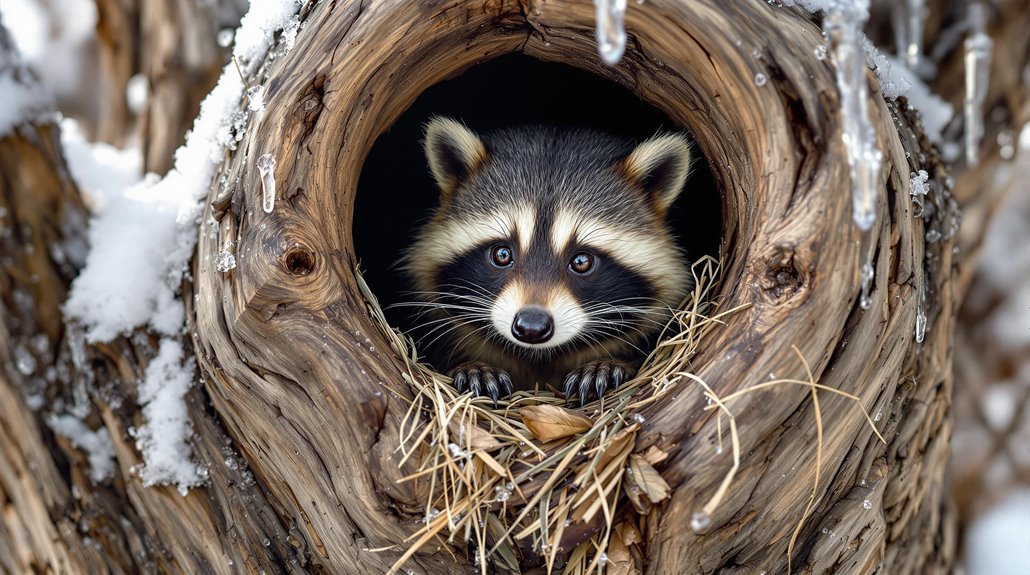
A suitable shelter is vital for raccoons, especially during the cold winter months. Raccoons seek out cozy spots that protect them from harsh weather. Their shelter preferences often include tree cavities, abandoned buildings, and even attics. These locations offer safety and warmth, which are essential for survival.
Raccoons are skilled at finding or creating nests. They use various nesting materials to make their shelters comfortable. Common materials include leaves, grass, and even discarded items. This resourcefulness guarantees they have a warm place to rest during the chilly nights.
| Shelter Preferences | Nesting Materials |
|---|---|
| Tree cavities | Leaves |
| Abandoned buildings | Grass |
| Attics | Rags |
| Burrows | Twigs |
| Rock crevices | Paper |
In Raleigh, NC, raccoons adapt to their environment by utilizing available resources. They often modify their shelters based on what they find. This ability to change helps them thrive in various conditions. Understanding their shelter and nesting habits can lead to better coexistence with these fascinating creatures.
Urban vs. Rural Raccoon Activity
Urban and rural raccoons exhibit different behaviors due to their habitats. In urban areas, raccoons often rely on human food sources, while rural raccoons depend more on natural food found in the wild. These differences in food availability and living conditions play a significant role in their winter activity.
Habitat Differences Impact Behavior
Differences in habitat can greatly influence the behavior of raccoons during the winter months. In urban areas, raccoons often seek shelter in man-made structures such as attics, garages, and dumpsters. These places provide warmth and safety from harsh weather. Their shelter preferences in cities lead to distinct behavioral adaptations. Raccoons become more active at night, taking advantage of reduced human activity to forage for food.
In contrast, rural raccoons tend to rely on natural shelters like hollow trees, dens, or brush piles. These habitats allow them to remain hidden from predators while still providing protection from the cold. Behavioral adaptations in rural areas may include a more varied range of activities, as they have access to different environments and food sources.
Food Sources in Seasons
Raccoons exhibit different foraging behaviors in urban and rural settings, particularly as seasons change. In urban areas, these animals often rely on human waste and pet food as primary food sources. Their foraging strategies include raiding trash cans and scavenging around parks and backyards. This behavior allows them to adapt quickly to the availability of food, especially during the colder months when natural sources become scarce.
In contrast, rural raccoons depend more on natural food sources such as fruits, nuts, and small animals. Their seasonal adaptations are evident as they prepare for winter by foraging for high-energy foods in the fall. This helps them build fat reserves to survive the winter months. As food becomes less available in winter, rural raccoons may travel greater distances to find sustenance.
Both urban and rural raccoons exhibit clever foraging strategies. However, the key difference lies in their reliance on human environments versus natural settings. Understanding these differences can help communities manage raccoon populations and maintain a balance between wildlife and urban living. By recognizing their habits, we can find ways to coexist with these adaptable creatures.
Social Dynamics of Raccoons
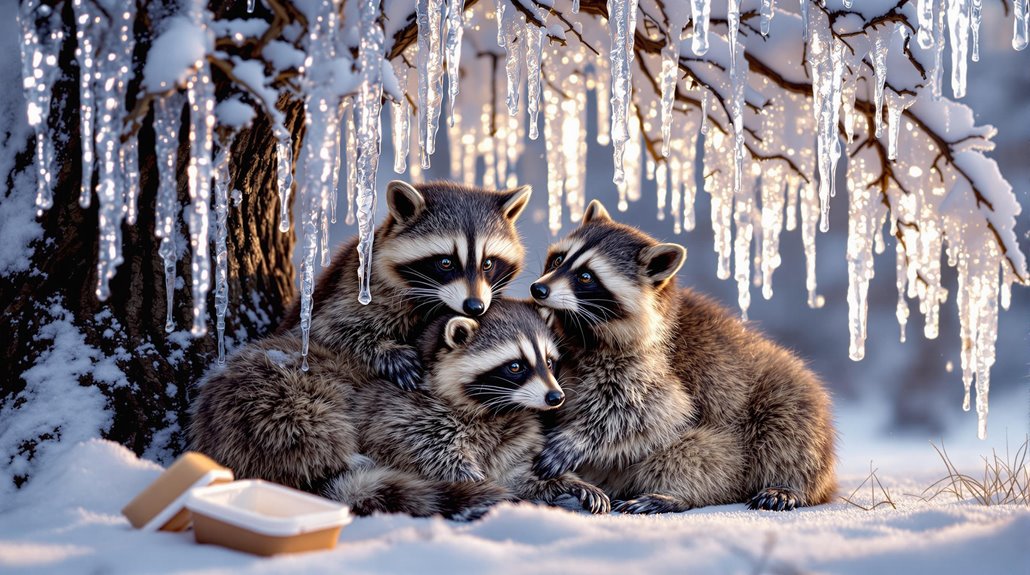
Raccoons display interesting social dynamics that influence their behavior. They often form groups, which helps them communicate and solve problems together. Additionally, these social structures can lead to territorial disputes as they establish their living areas.
Group Behavior Patterns
The social dynamics of raccoons reveal intriguing group behavior patterns that are crucial for their survival, especially during winter months. Raccoons often display a social hierarchy, where certain individuals lead group activities. This hierarchy helps maintain order during group foraging, allowing them to efficiently find food together. By working as a team, they can locate resources that might be difficult to find alone.
During colder months, raccoons engage in communal nesting, sharing warm spaces to protect against harsh weather. This behavior not only provides warmth but also fosters social bonds among members. Additionally, raccoons exhibit collective defense, working together to deter threats from predators. Their ability to collaborate enhances their chances of survival.
Play behavior is also common among raccoons, especially during seasonal gatherings. These playful interactions strengthen relationships and create a sense of community. Such gatherings allow young raccoons to learn critical skills from older members, ensuring their survival in the wild. Through these various group behavior patterns, raccoons demonstrate their adaptability and resourcefulness, key traits that help them thrive during the winter in Raleigh, NC.
Communication Methods
Effective communication is essential for maintaining the social dynamics within raccoon groups. Raccoons use various methods to interact with one another, ensuring harmony and cooperation. Vocalizations are a key component of their communication. Research shows that raccoons produce a range of sounds, including growls, screams, and chirps, each serving a specific purpose. These vocalizations can signal alarm, express distress, or communicate location.
In addition to vocalizations, body language plays a significant role in raccoon interactions. The position of their ears, tails, and bodies can indicate their feelings and intentions. For example, an upright tail may suggest excitement or curiosity, while a lowered tail could signal submission or fear. Observing these physical cues helps raccoons navigate their social environment and respond appropriately to one another.
Understanding these communication methods is vital for appreciating how raccoons maintain their social bonds. Effective communication fosters cooperation, enhances group cohesion, and ultimately contributes to their survival in challenging environments. By studying vocalizations and body language, we gain valuable insights into the complex social dynamics of raccoons, allowing us to better understand and appreciate these fascinating creatures.
Territorial Disputes
Engaging in territorial disputes is a common aspect of raccoon social dynamics. During winter, these disputes can intensify as raccoons seek to establish and defend their territories. Raccoons use various methods to communicate their presence and assert dominance over their domains. Territorial marking plays a critical role in this process, enabling them to leave scent trails that inform others of their boundaries.
Key factors in raccoon territorial disputes include:
- Scent Marking: Raccoons use urine and feces to mark their territory, deterring intruders.
- Aggressive Encounters: Conflicts may arise when raccoons come too close to each other's territory, leading to physical confrontations.
- Vocalizations: Loud calls and growls serve as warnings to potential rivals.
- Physical Displays: Raccoons may puff up their fur and posture to appear larger and more intimidating.
Understanding these behaviors offers insight into the social structures of raccoons. Their need for space and resources drives these interactions, reflecting a natural instinct to thrive and maintain independence in the wild.
Impact of Weather on Raccoons
Weather greatly influences raccoon behavior and survival during winter months. The temperature effects on their environment can shape how these animals adapt to the cold. In Raleigh, NC, winter brings colder temperatures that challenge raccoons to find food and shelter. As the weather gets harsher, raccoons may change their daily activities, becoming less active during the day and more active at night when temperatures are milder.
To cope with the cold, raccoons develop various survival strategies. They often seek shelter in trees, attics, or abandoned buildings to stay warm. Additionally, they may gather food when conditions allow, storing it for later use. Raccoons are opportunistic feeders and will take advantage of any available food sources, including garbage and pet food left outside.
During particularly cold spells, raccoons may go into a state of torpor, which allows them to conserve energy. This behavior helps them survive when food is scarce. Ultimately, the weather impacts not only their day-to-day activities but also their overall survival in the winter months. Understanding these patterns can help us appreciate the resilience of raccoons in changing conditions.
Human Interaction and Safety
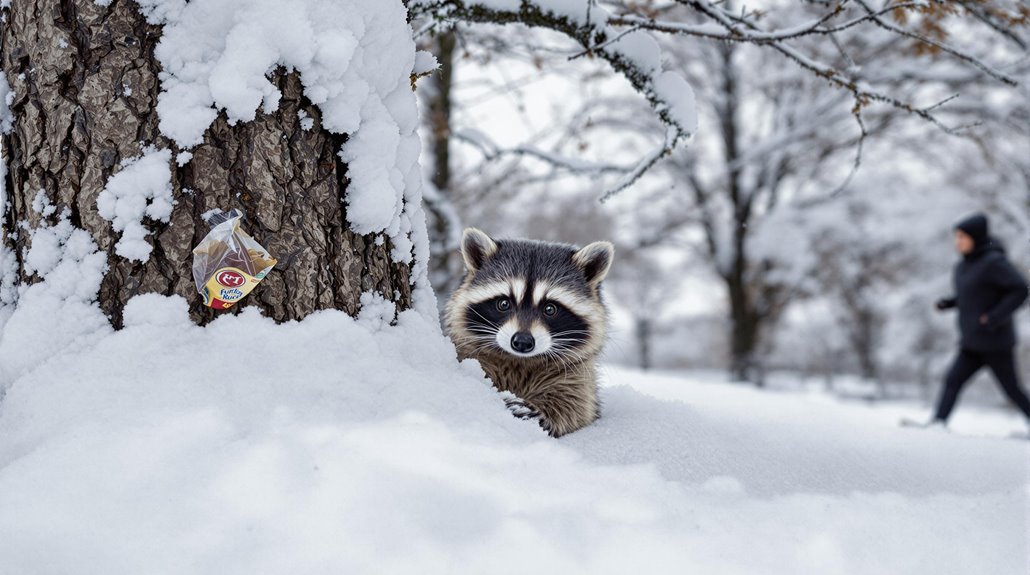
As raccoons adapt to the challenges of winter, their interactions with humans can increase, leading to potential safety concerns. Human encounters with raccoons may occur more frequently as these animals seek food and shelter. Understanding how to manage these interactions is important for both people and wildlife.
To guarantee safety, consider these precautions:
- Secure Trash Bins: Use raccoon-proof containers to prevent rummaging.
- Avoid Feeding Wildlife: Do not leave food out that could attract raccoons.
- Limit Outdoor Lighting: Bright lights can deter raccoons from entering yards.
- Educate Neighbors: Share information about raccoon behavior and safety measures within your community.
Tips for Wildlife Observation
Three key tips can enhance your experience while observing wildlife, especially raccoons during winter. First, consider using night vision equipment. This allows you to see raccoons more clearly in the dark, as they are primarily nocturnal. Second, learn raccoon tracking techniques. Understanding their tracks can help you find areas where they are active. Pay attention to paw prints and signs of foraging.
Here's a simple table to summarize these tips:
| Tip | Description | Benefits |
|---|---|---|
| Use Night Vision | Invest in night vision goggles or cameras | Better visibility at night |
| Learn Raccoon Tracks | Study tracks and signs left by raccoons | Locate active areas easily |
| Keep a Safe Distance | Observe from afar to avoid disturbing them | Enjoy nature without stress |
Lastly, always keep a safe distance. This guarantees both your safety and the well-being of the raccoons. By following these tips, you can enjoy a fulfilling wildlife observation experience in Raleigh, NC, while respecting the freedom of nature.
Frequently Asked Questions
Do Raccoons Hibernate During the Winter Months in Raleigh?
Raccoons do not hibernate during winter months. Instead, their behavior adapts for winter survival, seeking shelter and food sources. They may enter a state of torpor but remain active when conditions allow for foraging.
How Can I Tell if Raccoons Are Nearby?
To determine if raccoons are nearby, look for raccoon tracks in soft soil or snow. Their nocturnal behavior means they are most active at night, often leaving signs of foraging, such as overturned trash.
What Diseases Can Raccoons Carry in Winter?
Raccoons can carry diseases such as rabies and leptospirosis during winter. Their behavior, including scavenging and foraging, increases disease transmission risks to both humans and pets. Awareness and preventive measures are essential for safety.
Are Raccoons Active During the Day in Winter?
Raccoons, those clever nocturnal bandits, often flip the script in winter. While their primary behavior leans towards nighttime escapades, some may venture out during daylight hours, driven by hunger or environmental pressures affecting their winter habits.
How Do Raccoons Find Food in Snowy Conditions?
Raccoons adapt their foraging techniques in snowy conditions by relying on their keen sense of smell to locate food. Their winter diet often includes scavenged leftovers, nuts, and fruits buried under the snow or ice.
